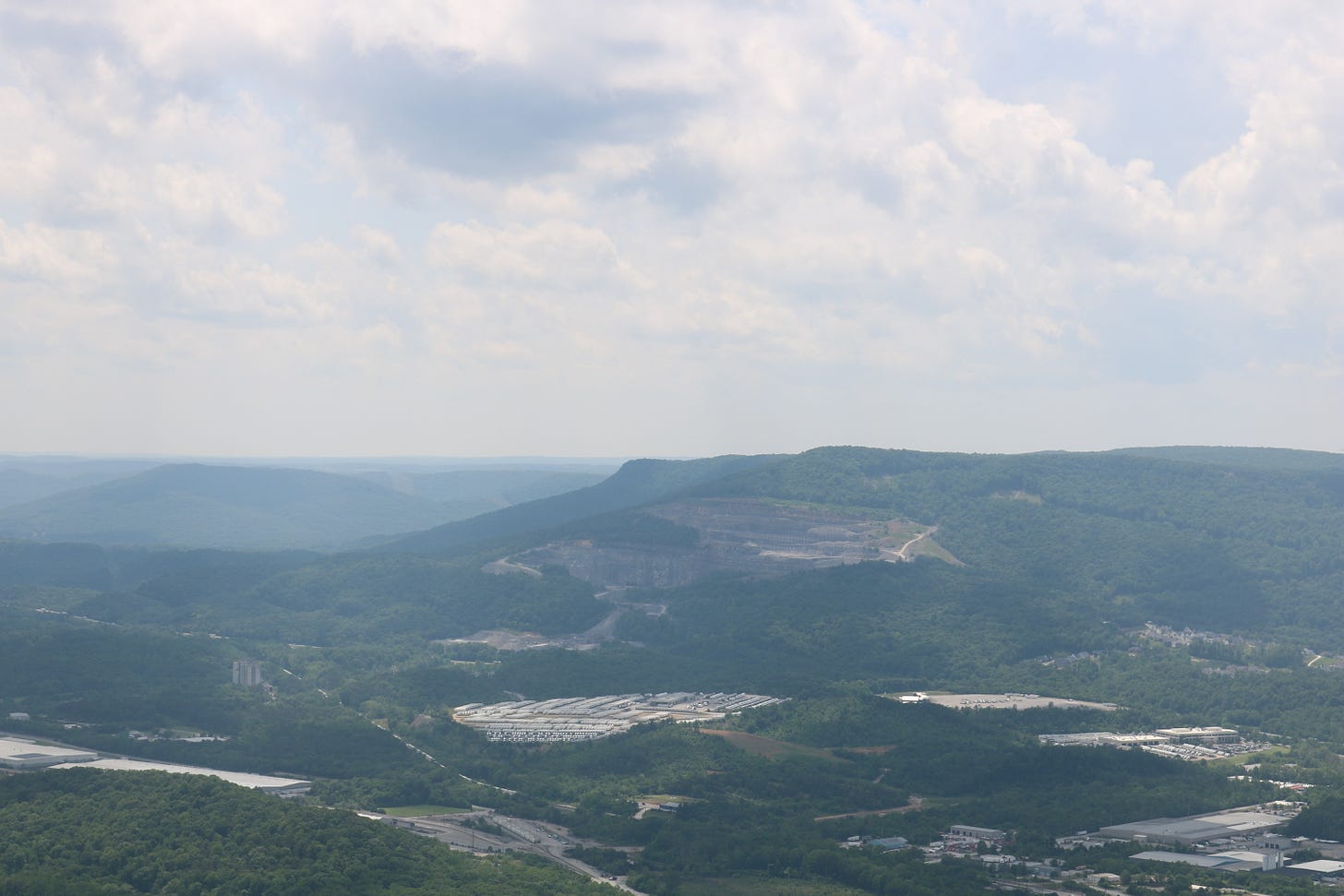Moccasin Bend viewed from Point Park. PHoto by Ray Zimmerman
1933 Outdoors in the Cumberlands, The Cumberlands Hiking Club, Chattanooga, Tennessee.
Robert Sparks Walker edited this volume and wrote the introduction and four of the pieces. This book goes beyond hiking opportunities and addresses natural history as well. Various club members authored articles on Geology, Archaeology, Fungi, Wildflowers, etc. Walker is listed as an "other author" in the card catalogs. He is also credited for starting the club and promoting hiking. Active members of the Cumberlands Hiking Club continue the hiking tradition today.
This book is printed on 8.5 X 11 paper, folded in half, and saddle stapled. Some copies were later bound to preserve them.
Robert Sparks Walker’s poem, “The Voice of the Trail,” appears first in the book. His brief preface includes Chattanooga’s location and some statistics.
Alfred Mynders wrote an introductory chapter, "This Solitude called Peace." He focused on the aesthetics of the natural beauty of the Cumberlands.
Dr. Wilbur K. Butts authored the section on geology. He described how precipitating minerals become limestone rock and how the bodies of sea creatures are incorporated. He gives locations where remnants from the various periods of the Paleozoic era are evident, from the Cambrian to the Pennsylvanian, but noted the absence of fossils from the Permian period. His discussion of synclines, the shallow inland sea, the Cincinnati Arch, and other Geological features is a solid starting point for Chattanooga Geology.
John P. Brown authored "Archaeology Around Chattanooga," beginning with a discussion of work by the Peabody Institute and Clarence B. Moore. His text includes descriptions of findings at Moccasin Bend, Williams Island, Nickajack Shell Mounds, and rock overhangs on Lookout Mountain.
John P. Brown authored “Archaeology Around Chattanooga.” His discussion of local sites included:
• Moccasin Bend • Williams Island • Lookout Mountain • Nickajack and Running Water Villages • Chickamauga Creek • Baylor School • The Tennessee River shoreline • Sites along the Little Tennessee River • Rock forts including Fort Mountain (Chatsworth, Georgia) • Old Stone Fort (Manchester, Tennessee) • A stone structure near Desoto Falls (Mentone, Alabama)
The “stone sturcture near Desoto Falls” may be a reference to a rock overhang I have visited on ocasion. It escaped attention for years, but is now well known and a popular place for visitation. A local person there told me that it was once a popular place for artifact collecors, and that anything of significance is gone by now. The stone wall associated with it is said to have been raided for chimney stones.
His discussion also includes the Cherokee Reservation near Cherokee, North Carolina. It is interesting that he included a contemporary culture in a chapter on Archaeology. I have visited some of the publicly accessible sites in Cherokee, North Carolina, and found them to be interesting, but it is important to recognize them as vibrant cultural resources for a living tradition and not part of the past.
Charles W Lusk wrote a chapter titled “Springs in the Chattanooga Area.” Some are single springs such as the Cherokee Council Spring, now part of Red Clay State Park (Tennessee) and known as “The Blue Hole.” Other sites are the locations of multiple springs such as the Varnell Springs which he stated had forty springs and seeps, located near Varnell, Georgia. He lists the rate of flow for each spring, the stream each spring flows into, and the river that the stream feeds.
The listed springs are:
• Blue Spring, Birchwood, Tennessee • Anderson Spring, McDonald, Tennessee • Cave Spring, near Hixson, Tennessee, and ¾ mile east of Dayton Pike. • Owens Blowing Spring, north of Jasper, Tennessee in Sequatchie County • Crawfish Spring, Chickamauga, Georgia • Grants Blowing Spring, Chattanooga Valley (east side of Lookout Mountain) • Cherokee Council Spring (The Blue Hole) near Collegedale, Tennessee • Flint Spring, Bradley County, Tennessee, significant to Chief John Ross • Yates Spring • Leets Spring, site of a Civil War Battle • Ellis’s Springs (2) between Fort Oglethorpe and Rossville, Georgia, Peavine Creek • Varnell Springs, Whitfield County, Georgia • Freeman’s Spring and Lake, Whitfield County, Georgia • Catoosa Springs, Catoosa County, Georgia
Additional chapters explore the following topics
• Lightning by Robert Sparks Walker • Trees and Wildflowers by Elanor McGillard • Insects and Spiders by Robert Sparks Walker • Mushrooms by Dr, Wilbur K. Butts • Birds about Chattanooga by Robert Sparks Walker • Hiking Trails of Chattanooga by Donna Davidson • Hiking Trails in Chattanooga-Lookout Mountain Park by Elizabeth Lockwood • Edible Wild Fruits by Robert Sparks Walker • Index (a table of contents) • Hiking suggestions
The “Lookout mountain park mentioned in this list is now the Point Park unit of the Chickamauga and Chattanooga National Military Park. Walker mentions having worked with that park elsewhere in his writings.
Looking west from Sunset Rock. Photo by Ray Zimmerman.





